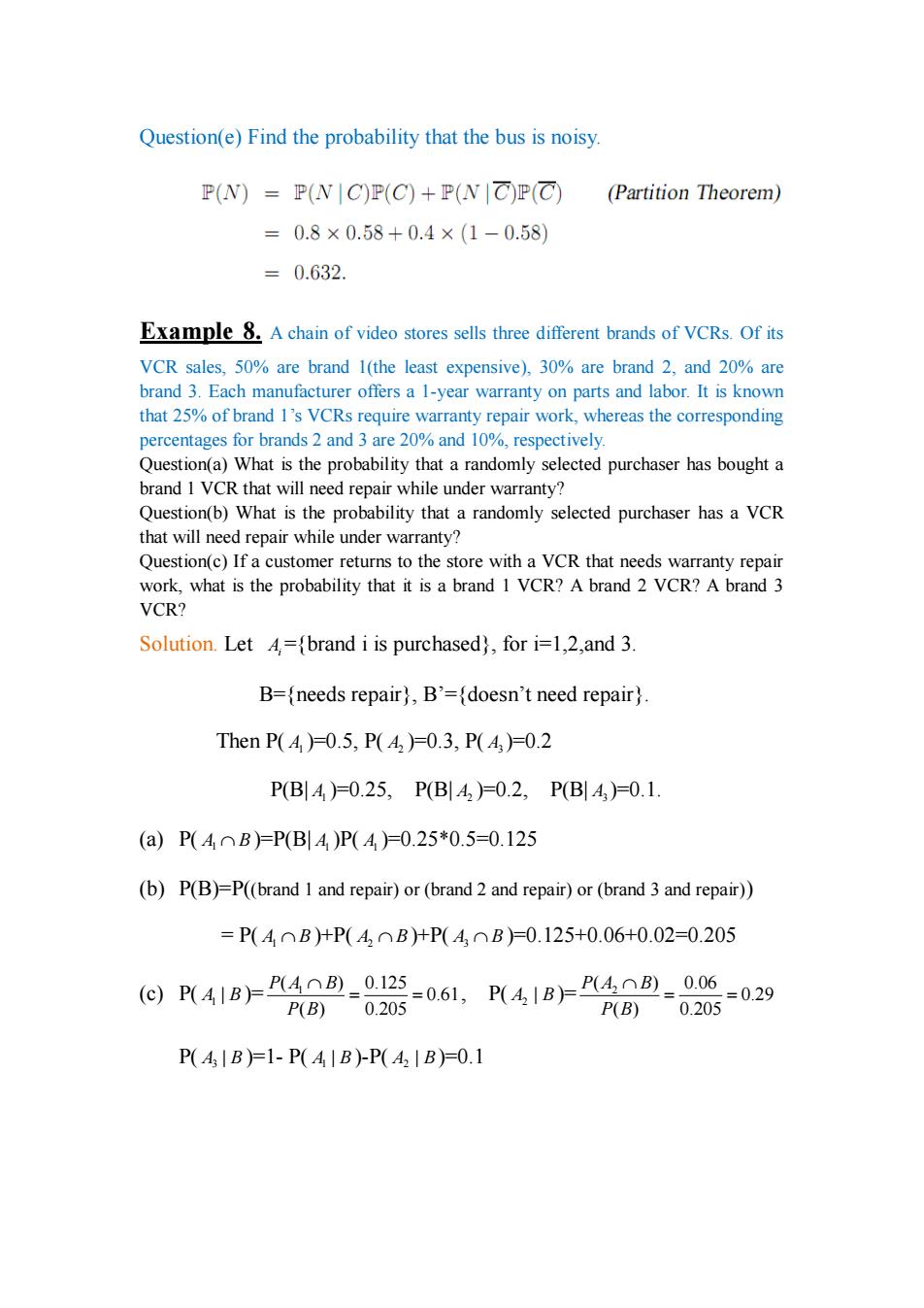正在加载图片...

Question(e)Find the probability that the bus is noisy P(N)=P(N |C)P(C)+P(N C)P(C)(Partition Theorem) =0.8×0.58+0.4×(1-0.58) =0.632 Example 8.A chain of video stores sells three different brands of VCRs.Of its VCR sales,50%are brand 1(the least expensive),30%are brand 2,and 20%are that 25%of brand 1's VCRsr require v warranty repair work, hereas the corresponding percentages for brands 2 and 3 are 20%and 10%,respectively Question(a)What is the probability that a randomly selected purchaser has bought a brand 1 VCR that will need repair while under warranty? Question(b)What is the probability that a randomly selected purchaser has a VCR work,what is the probability that it is a brand 1 VCR?A brand 2 VCR?A brand 3 VCR? Solution.Let ,={brand i is purchased),for i=1,2,and 3. B=(needs repair),B'=(doesn't need repair) Then P(A0.5,P(A2)0.3,P(A)0.2 PBl4=0.25,P(BA)=0.2,PB4)=0.1 (a)P(4nB)=P(BlA)P(4)=0.25*0.5=0.125 (b)P(B)=P((brand I and repair)or(brand 2 and repair)or (brand 3 and repair)) =P(4nB+P(4nB+P(4,⌒B)=0.125+0.06+0.02-=0.205 日41eA-8-06,41nA0-8器-029 PB)0.205 P(41B)=1-P(41B)-P(421B)=0.1Question(e) Find the probability that the bus is noisy. Example 8. A chain of video stores sells three different brands of VCRs. Of its VCR sales, 50% are brand 1(the least expensive), 30% are brand 2, and 20% are brand 3. Each manufacturer offers a 1-year warranty on parts and labor. It is known that 25% of brand 1’s VCRs require warranty repair work, whereas the corresponding percentages for brands 2 and 3 are 20% and 10%, respectively. Question(a) What is the probability that a randomly selected purchaser has bought a brand 1 VCR that will need repair while under warranty? Question(b) What is the probability that a randomly selected purchaser has a VCR that will need repair while under warranty? Question(c) If a customer returns to the store with a VCR that needs warranty repair work, what is the probability that it is a brand 1 VCR? A brand 2 VCR? A brand 3 VCR? Solution. Let Ai ={brand i is purchased}, for i=1,2,and 3. B={needs repair}, B’={doesn’t need repair}. Then P( A1 )=0.5, P( A2 )=0.3, P( A3 )=0.2 P(B| A1 )=0.25, P(B| A2 )=0.2, P(B| A3 )=0.1. (a) P( A1 B )=P(B| A1 )P( A1 )=0.25*0.5=0.125 (b) P(B)=P((brand 1 and repair) or (brand 2 and repair) or (brand 3 and repair)) = P( A1 B )+P( A2 B )+P( A3 B )=0.125+0.06+0.02=0.205 (c) P( A1 | B )= 0.61 0.205 0.125 ( ) ( ) 1 P B P A B , P( A2 | B )= 0.29 0.205 0.06 ( ) ( ) 2 P B P A B P( A3 | B )=1- P( A1 | B )-P( A2 | B )=0.1